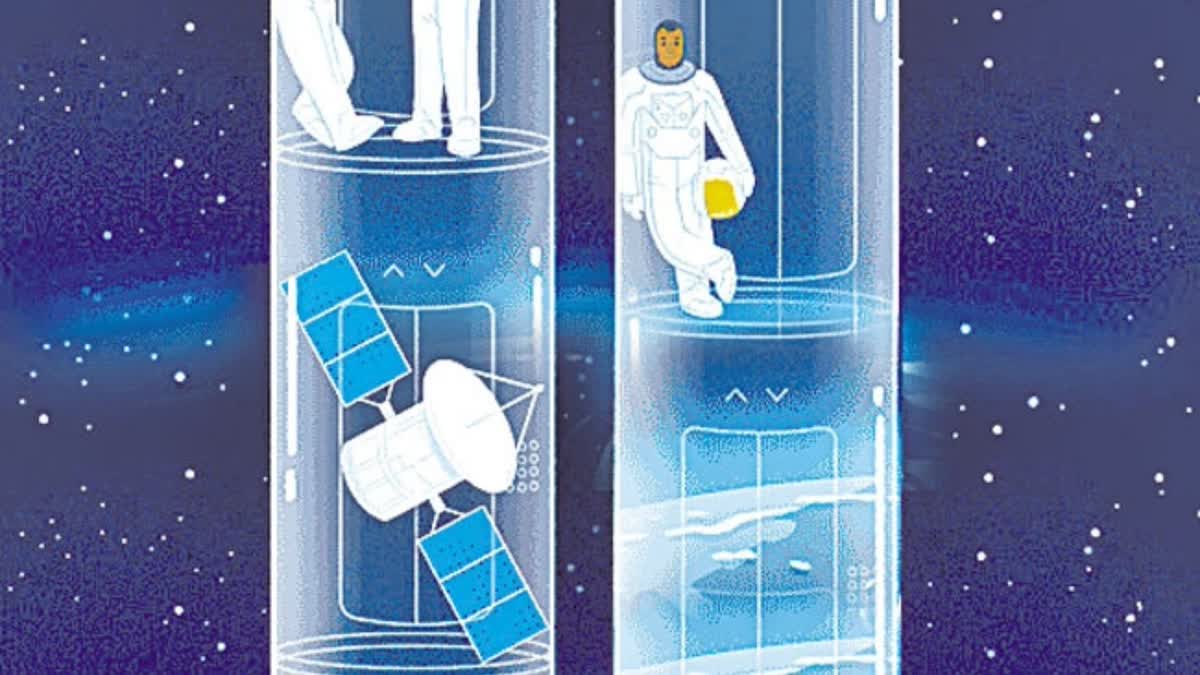Hyderabad : We use the lift to easily reach the upper floor of the building. If the same goes up further? If you can reach Space..! It all sounds like science fiction, doesn't it? A Japanese company is working to get a massive space elevator project off the rails, which has been limited to ideas for years. It is planning to start the works from next year. If realized, it would be very easy and cheap to move people and goods into space.
A 130-year-old idea: Russian rocket scientist Konstantin Tsiolkovsky first conceived the idea of this space lift. It is mentioned in the book 'Dreams of Earth and Sky' written by him in 1895. In it, he describes an imaginary tower 22,000 miles high. This idea was taken further by Russian engineer Yuri Artstanov. It is proposed to establish a cable from the Earth to a satellite in a geostationary orbit, and with its help, space travel should be done.
What is a lift? Japan's Obayashi Corporation decided to bring that idea into reality. This company has a history of realizing revolutionary projects like the world's largest TV tower 'Tokyo Skytree'. The lift proposed by this company is called Space Elevator. It enables trips into and out of Earth's orbit. Obayashi hopes to start its construction next year and complete it by 2050.
It works like this: As part of the construction of the space elevator, a cable will be laid from Earth to the satellite in geostationary orbit in Space. This satellite has the same rotational speed as the Earth. Therefore it always remains at a specific place above the earth. The space lift cable extends to a height of 96 thousand kilometers from the earth. Its counterweight is here. An 'Earth Port' will be established in the ocean in the equatorial region.
Earth port contains ballast. The cable tension is also adjusted there. Another center will be set up on the ground near the Earthport. From there to reach the earth port in the ocean, a tunnel will be set up under the ocean. With the help of this cable, electromagnetic vehicles called climbers go up and down. Humans can travel in them. The goods can be transported.
Many centers: As part of the space elevator project, the Jio station will be built at a height of 36 thousand kilometers along the cable. Visitors can go there and view the universe in zero gravity conditions. Geostationary satellites can be launched from there.
Carbon nanotube: A Mars gravity center can be established along this cable at an altitude of 3,900 km. It has about as much gravity as the surface of Mars. Also, a lunar gravity center can be established at an altitude of 8,900 km. There is gravitational force at the surface level of the moon. Experiments and training of astronauts can be done in these two centers.
At an altitude of 23,750 km, a low earth orbit gate (Leo Gate) will be established. Leo satellites can be launched from there. They reach an orbit 300 km above the earth and rotate there.
Solar power stations can be set up in geostationary orbit with the help of this lift. The electricity generated there can be sent to Earth.
At an altitude of 57 thousand kilometers, there is a 'Mars Gate'. From there we can send spacecraft to Mars.
A 'Solar Family Exploration Gate' will be set up at the counterweight center at an altitude of 96,000 kilometers from Earth. Spacecraft can be easily sent to Jupiter and asteroids by using the rotation speed of that place. Obayashi says that precious resources can be collected from asteroids and brought back to Earth.
Benefits: Rockets are currently used for space experiments. Huge harmful emissions come out of them. Space elevators do not need rocket fuels. This includes electromagnetic vehicles. They can also run on solar power. Therefore, the impact on the environment can be significantly reduced.
The cost of space travel will also come down significantly. SpaceX currently charges $1,227 per pound (0.45 kg) of payload into space with the Falcon 9 spacecraft. Obayashi's firm says that with a space elevator, that would drop to $57.
It usually takes 6-8 months to reach Mars. With the help of a space elevator, we can reach there in 3-4 months. If necessary, you can go in 40 days.
A space elevator travels at a speed of 200 kilometers per hour slower than a rocket. Therefore, there will be no vibrations and jolts in this journey. It is suitable for carrying sensitive instruments into space.
Challenges: Realizing this space elevator is not as easy as it seems. There are many engineering hurdles. The main challenge is to make the 96 thousand km long cable. It should be easy. At the same time, it should be strong. Obayashi's organization says that this requires knowledge of carbon nanotubes. It is very light and strong. However, some experts doubt whether it is possible to build such a long cable with this material.
The stability of the cable should be maintained. Extreme weather conditions such as thunder, lightning, storms, and space debris pose a threat to this elevator. These should be overcome.
Read More:



